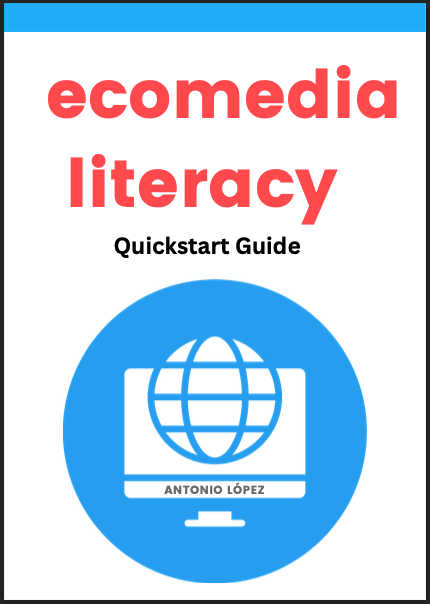Professor Antonio Lopez Publishes New E-Book on Ecomedia Literacy

Communications Professor Antonio Lopez recently published Ecomedia Literacy. A Quickstart Guide (ecomedialiteracy.org, 2024). This short e-book provides new insights for educators on how to integrate environmental awareness and media studies into curricula across disciplines, while also encouraging students to develop critical thinking skills and be informed on the latest environmental issues.
Download Ecomedia Literacy. A Quickstart Guide
What inspired you to create the Ecomedia Literacy Quickstart Guide?
As a professor and researcher, I have been focused on bridging the gap between ecojustice and media literacy. We are facing a huge climate crisis, and it is clear that we need to do something about it in our schools and universities. I saw more and more students getting engaged with environmental activism, and I wanted to create something practical that could be used to bring sustainability into their classes, but also enhance their media skills. My goal was to give educators a tool they can use to tackle these big issues in their classrooms.
How would you define ecomedia literacy for educators who are new to the concept?
Ecomedia literacy is about exploring the connections between media, tech, and environmental sustainability. It focuses on two aspects: first, how our media systems and technologies impact the environment – what we call ”ecomedia footprint;” then, how media shapes our understanding of environmental issues – that is the “ecomedia mindprint.” This is about how media influences our awareness, beliefs, and actions when it comes to the environment. For teachers who are new to this, think of ecomedia literacy as a big-picture approach to education. It’s not just about one subject – it brings together different disciplines.
What are some of the key learning objectives educators should focus on when introducing ecomedia literacy to their students?
When we are introducing ecomedia literacy to students, there are a few key things we really want them to understand. First off, we want them to grasp the real-world impact of all the technology we use. For instance, they should learn about all the energy required to provide raw materials for our phones, or the extensive amounts of water used by artificial intelligence. Then, we want students to look critically at how climate change and sustainability are presented in the news or social media, so that they can understand if big tech companies and media organizations are practicing what they preach, when it comes to being green.
Another big goal is to get students to create and share their own media on environmental issues, which will hopefully have an impact and will get people thinking and acting on these problems. Finally, we would like students to dig deep into the stories and ideas behind environmental media, to ask themselves, “What assumptions are being made? What worldviews are being pushed?” We want them to be able to unpack all of that. By focusing on all these things, we’re giving students the tools they need to be smart and critical consumers of media, but also responsible creators when it comes to environmental issues. We want them to feel like they can make a difference. It is amazing seeing students combine critical thinking, digital responsibility, and environmental awareness and really engage with these issues in a meaningful way.
Can you give some examples of an ecomedia literacy activity that teachers could easily implement in their classrooms?
One activity I really like is the critical analysis of electric vehicle (EVs) ads from the Super Bowl. Students should analyze how the ads frame environmental issues, and their use of visual and audio elements to convey messages and environmental worldviews. For a more hands-on approach, students can do an ecomedia footprint project. By tracking their media habits, they can learn about their environmental impact, looking at energy consumption, e-waste, and data center influence. Another easily implementable activity is the analysis and creation of climate memes. Students can search for climate memes online, analyze their messages and visual elements, and then create their own using a meme-generator website. This would help them understand visual metaphors and climate framing.
Lastly, a more advanced activity could be an ecomedia policy analysis. Students choose a big tech company and research their environmental policies and practices, which would make them delve into the intersection of corporate policy, technology, and environmental impacts. These activities help students engage with ecomedia literacy concepts in practical, analytical ways that connect to real-world issues and practices, and most importantly, their lives.
What advice would you give to educators who want to incorporate ecomedia literacy into their curriculum but don’t know where to start?
This short e-book provides an accessible introduction. I would also suggest that educators explore the resources available on ecomedialiteracy.org, which offers curriculum materials and learning activities. Begin with simple things, like analyzing media representations of environmental issues or creating eco-conscious media messages. Gradually incorporate more complex concepts and projects as you and your students become more comfortable with ecomedia literacy. Remember that the goal is to integrate ecology into education across the curriculum, so look for opportunities to connect environmental topics with media analysis and mediamaking in your existing curriculum.
Professor Antonio Lopez teaches Communications and Media Studies at JCU. He is also a curriculum designer, educator, trainer, and theorist whose research focuses on bringing together environmental awareness and media literacy. He has published several works, including Ecomedia Literacy & SDGs: A Handbook for Higher Ed, The Routledge Handbook of Ecomedia Studies, and Ecomedia Literacy: Integrating Ecology into Media Education, which can be explored on his website, ecomedialiteracy.org.





